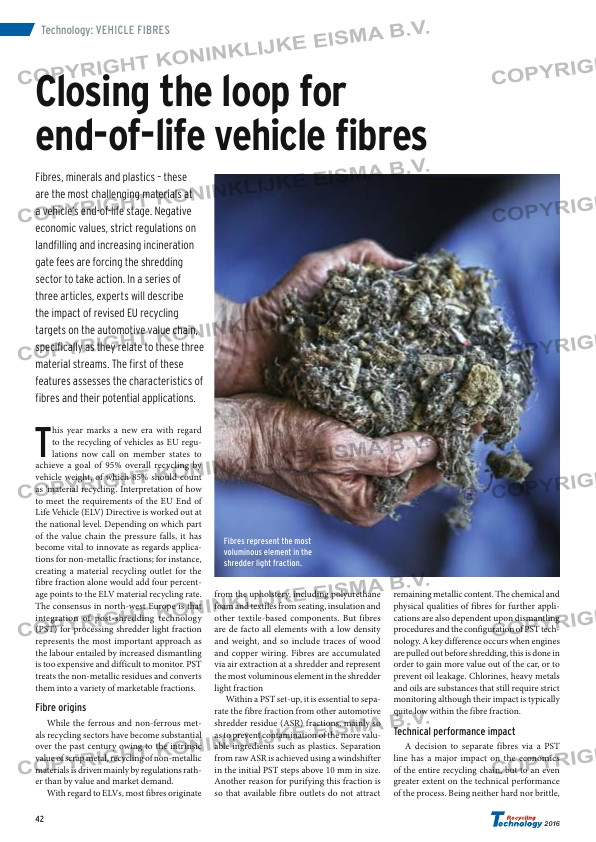Page 42 from: Recycling Technology 2016

42
2016
Technology: VEHICLE FIBRES
Closing the loop for
end-of-life vehicle fibres
Fibres, minerals and plastics – these
are the most challenging materials at
a vehicle’s end-of-life stage. Negative
economic values, strict regulations on
landfilling and increasing incineration
gate fees are forcing the shredding
sector to take action. In a series of
three articles, experts will describe
the impact of revised EU recycling
targets on the automotive value chain,
specifically as they relate to these three
material streams. The first of these
features assesses the characteristics of
fibres and their potential applications.
T
his year marks a new era with regard
to the recycling of vehicles as EU regu-
lations now call on member states to
achieve a goal of 95% overall recycling by
vehicle weight, of which 85% should count
as ‘material recycling’. Interpretation of how
to meet the requirements of the EU End of
Life Vehicle (ELV) Directive is worked out at
the national level. Depending on which part
of the value chain the pressure falls, it has
become vital to innovate as regards applica-
tions for non-metallic fractions; for instance,
creating a material recycling outlet for the
fibre fraction alone would add four percent-
age points to the ELV material recycling rate.
The consensus in north-west Europe is that
integration of post-shredding technology
(PST) for processing shredder light fraction
represents the most important approach as
the labour entailed by increased dismantling
is too expensive and difficult to monitor. PST
treats the non-metallic residues and converts
them into a variety of marketable fractions.
Fibre origins
While the ferrous and non-ferrous met-
als recycling sectors have become substantial
over the past century owing to the intrinsic
value of scrap metal, recycling of non-metallic
materials is driven mainly by regulations rath-
er than by value and market demand.
With regard to ELVs, most fibres originate
from the upholstery, including polyurethane
foam and textiles from seating, insulation and
other textile-based components. But fibres
are de facto all elements with a low density
and weight, and so include traces of wood
and copper wiring. Fibres are accumulated
via air extraction at a shredder and represent
the most voluminous element in the shredder
light fraction
Within a PST set-up, it is essential to sepa-
rate the fibre fraction from other automotive
shredder residue (ASR) fractions, mainly so
as to prevent contamination of the more valu-
able ingredients such as plastics. Separation
from raw ASR is achieved using a windshifter
in the initial PST steps above 10 mm in size.
Another reason for purifying this fraction is
so that available fibre outlets do not attract
remaining metallic content. The chemical and
physical qualities of fibres for further appli-
cations are also dependent upon dismantling
procedures and the configuration of PST tech-
nology. A key difference occurs when engines
are pulled out before shredding, this is done in
order to gain more value out of the car, or to
prevent oil leakage. Chlorines, heavy metals
and oils are substances that still require strict
monitoring although their impact is typically
quite low within the fibre fraction.
Technical performance impact
A decision to separate fibres via a PST
line has a major impact on the economics
of the entire recycling chain, but to an even
greater extent on the technical performance
of the process. Being neither hard nor brittle,
Fibres represent the most
voluminous element in the
shredder light fraction.



